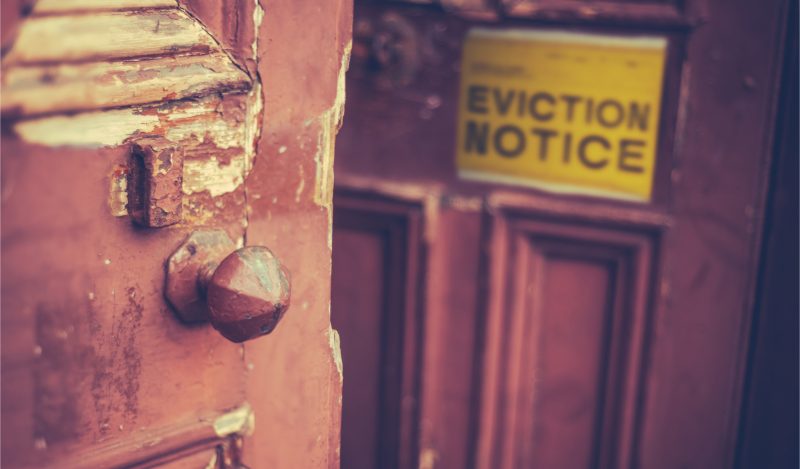It took a year and a half but the deed is finally done. In a 6-3 decision, the highest court has called out the out-of-control agency that has been imposing itself on all aspects of American life for this past year. The majority opinion makes for fascinating reading, if only because the author or authors (the opinion is unsigned) expresses genuine alarm at the same reality that has wrecked the lives of billions of people all over the world. Our basic rights and liberties have been trampled on by states presuming no limits on their powers, and there has heretofore been very little in the way of judicial resistance.
The case is “Alabama Association of Realtors, et al v. Department of Health and Human Services, et al” and it pertained to the eviction moratorium first issued by the CDC on September 4, 2020, under the authority of the Trump administration. Citing the need to control Covid, it did not permit people to skip out on their rents but it did impose criminal penalties including fines up to $500,000 and jail time on landlords who kick people out for failing to do so. So, yes, the CDC essentially legalized squatting, and there are reports of abuse all over the country. Indeed, the vetting of renters today is far more intense than it was two years ago, a change that certainly harms marginal applicants and people with questionable credit histories.
And why did all this happen? To stop Covid of course. The original edict read as follows:
In the context of a pandemic, eviction moratoria—like quarantine, isolation, and social distancing—can be an effective public health measure utilized to prevent the spread of communicable disease. Eviction moratoria facilitate self-isolation by people who become ill or who are at risk for severe illness from COVID-19 due to an underlying medical condition. They also allow State and local authorities to more easily implement stay-at-home and social distancing directives to mitigate the community spread of COVID-19. Furthermore, housing stability helps protect public health because homelessness increases the likelihood of individuals moving into congregate settings, such as homeless shelters, which then puts individuals at higher risk to COVID-19. The ability of these settings to adhere to best practices, such as social distancing and other infection control measures, decreases as populations increase. Unsheltered homelessness also increases the risk that individuals will experience severe illness from COVID-19.
Yes, we get it. If the government says “stay home and stay safe” – no state anywhere under any conditions should have that legal right to impose upon people’s right of movement – you can’t have landlords telling people to get the heck out of Dodge because they haven’t forked over for rent. Look, I’m highly sympathetic to people who can’t pay especially given the public policy that forced people not to work. At the same time, people who have counted on rent from tenants need some way of enforcing their contracts. The CDC essentially overrode their rights based on completely unverified claims of disease spread. Indeed, the CDC deleted the 500-year trajectory of the liberal project, and did so without consultation much less democratic authorization. The CDC led and achieved a coup against liberal democracy.
The legal basis for doing so, the CDC claimed, is its powers under the wartime-era Public Health Services Act, (1944) and, in particular, its section 361, which permits government the following: “The Surgeon General, with the approval of the Secretary of Health and Human Services, is authorized to make and enforce such regulations as in his judgment are necessary to prevent the introduction, transmission, or spread of communicable diseases from foreign countries into the States or possessions, or from one State or possession into any other State or possession.”
As examples of the thinking behind such powers, the law cites the need for “inspection, fumigation, disinfection, sanitation, pest extermination, destruction of animals or articles found to be so infected or contaminated as to be sources of dangerous infection to human beings, and other measures, as in his judgment may be necessary.”
The notion that the CDC could involve itself in comprehensive economic planning was unthinkable, but such bureaucratic claims have been on the books for at least 15 years. I noticed them in 2006 when George W. Bush attempted to whip up a national frenzy about the coming bird flu that never actually arrived. His administration claimed but never deployed the authority to “use governmental authorities to limit non-essential movement of people, goods and services into and out of areas where an outbreak occurs.”
When Covid hit, the CDC became the weapon of choice in enacting lockdowns and stay-at-home orders in the name of public health. With the eviction moratorium, the CDC pushed its powers to the limit, essentially nationalizing all private residential property and forbidding its own from making and enforcing contracts over its use. It stood between willing buyers and sellers of rental services and announced new terms that would pertain to everyone, all in the name of stopping the spread of a pathogen. It was the same rationale behind the forced quarantines, the church closures, the shutdowns of businesses, and every other mandate that has vexed us for a year and a half.
When I first spotted these on-the-books powers 15 years ago, I wondered whether they had ever been approved by Congress. The answer is no: they have never been approved in these specific applications nor tested by the courts.
The Supreme Court now notes how unprecedented the application of these powers are:
Originally passed in 1944, this provision has rarely been invoked—and never before to justify an eviction moratorium. Regulations under this authority have generally been limited to quarantining infected individuals and prohibiting the import or sale of animals known to transmit disease. See, e.g., 40 Fed. Reg. 22543 (1975) (banning small turtles known to be carriers of salmonella).
(As a side note, I recall this turtle ban, and that it made me furious as a kid. I loved those little turtles. They never made me sick. They would swim in a little green pool next to my bed and hang around under a plastic palm tree. Then one day I couldn’t buy them anymore, thanks to the CDC. I’m angry now all over again, especially now that I know the source of the ban.)
The Court then distinguishes between the power to directly control a disease and the power to control the downstream spread of a disease by imposing on the whole population certain measures that would only apply to a subset of people. It’s one thing to force an Ebola patient into quarantine and something else entirely to impose a mandate for the whole population based on the possibility that someone might have or acquire Ebola. This is the court’s view in any case.
“At least 80% of the country, including between 6 and 17 million tenants at risk of eviction, falls within the moratorium,” the court notes. “Indeed, the Government’s reading of §361(a) would give the CDC a breathtaking amount of authority. It is hard to see what measures this interpretation would place outside the CDC’s reach, and the Government has identified no limit in §361(a) beyond the requirement that the CDC deem a measure ‘necessary.’”
Could the CDC, for example, mandate free grocery delivery to the homes of the sick or vulnerable? Require manufacturers to provide free computers to enable people to work from home? Order telecommunications companies to provide free high-speed Internet service to facilitate remote work?
This claim of expansive authority under §361(a) is unprecedented. Since that provision’s enactment in 1944, no regulation premised on it has even begun to approach the size or scope of the eviction moratorium. And it is further amplified by the CDC’s decision to impose criminal penalties of up to a $250,000 fine and one year in jail on those who violate the moratorium. See 86 Fed. Reg. 43252; 42 CFR §70.18(a). Section 361(a) is a wafer-thin reed on which to rest such sweeping power.
One has to express gratitude to see the Court finally speaking clearly on what an outrageous abuse of power is really behind the CDC’s claims and regulations. They are completely unlawful, which is to say that CDC in this case is operating as a lawless agency.
It is indisputable that the public has a strong interest in combating the spread of the COVID–19 Delta variant. But our system does not permit agencies to act unlawfully even in pursuit of desirable ends.
Let’s take a quick look at the dissenting opinion, if only to see how close we came to having such outrages codified as the law of the land. The dissent was written by Justice Stephen Breyer and signed by Elena Kagan and Sonia Sotomayor. In their view “the CDC [has the] authority to design measures that, in the agency’s judgment, are essential to contain disease outbreaks. The provision’s plain meaning includes eviction moratoria necessary to stop the spread of diseases like COVID–19.”
Then they go on to copy and paste a chart on the rise of infections, despite extremely widespread doubt about the science behind PCR testing, whether and to what extent these infections are symptomatic, and whether and to what extent they are linked to hospitalization and death. The link between positive PCR tests and severe outcomes has clearly been broken, as data from Florida and many states have shown.
Not that any trend lines in virus spread should impact a court’s judgement on whether totalitarian powers are justified. These people are supposed to be jurists, not epidemiologists. It is precisely because of such “emergency use authorizations” of despotic controls that we found ourselves in this predicament to begin with. The dissent essentially dismisses all concerns for human rights and legal limits on state power: “The public interest strongly favors respecting the CDC’s judgment at this moment, when over 90% of counties are experiencing high transmission rates.”
The dissent, for that matter, could have been written by Anthony Fauci. What we have here is a Court intrigued by the goal of zero Covid and of the belief that the CDC should have unlimited power to bring about such a result. It’s a position not different from policies you see today in Australia and New Zealand that have led to the construction of police-enforced concentration camps for infected people and the implementation of despotic mechanisms of futile attempts at virus control.
In any case, it is deeply disappointing to see a dissent coming from the Supreme Court that cuts and pastes public domain infection charts rather than, say, looking to the US Constitution as a final source of authority. At least these Justices remain in the minority for now.
By a 6-3 vote, then, we finally have a ray of hope that the Supreme Court of the US will not be wholly silent as American liberties and limits on government slip away entirely under the cover of public health. Finally the CDC has encountered some pushback after a year and a half of exercising powers over the American population never before experienced, and few would have imagined possible only two years ago.
Join the conversation:


Published under a Creative Commons Attribution 4.0 International License
For reprints, please set the canonical link back to the original Brownstone Institute Article and Author.









